Want to resolve your chronic pain forever, without having to rely on doctors, drugs or surgery?
There are 1.5 billion people in the world suffering from chronic pain. [1] And, according to one of the most well-respected medical journals in the world, that number is expected to RISE SIGNIFICANTLY in the coming years because of two main factors:
- A general aging of the world’s population.
- A global population shift from rural areas and lower income countries to more developed parts of the world and the adoption of the modern lifestyle. [2]
Chronic pain is a worldwide problem but, people in all parts of the world DO NOT suffer equally.
There are places in the world where chronic pain levels are a fraction of that in other areas. Back pain, for example, is as much as 400% greater in developed countries. Even if we look at undeveloped countries in isolation, back pain rates among urban are far greater populations than among rural populations. [3,4,5]
The main reason for the increased pain associated with modern living comes down to something I call Kinetic Flow. Kinetic Flow is also the one factor that those suffering with pain and their doctors consistently overlook and is solely responsible for keeping hundreds of thousands of people stuck in pain. If getting out of chronic pain is the goal, then knowing how to use Kinetic Flow is the difference between success and failure.
Over the last 25 years, science has made some truly remarkable discoveries regarding the critical role that movement plays in human health. These discoveries, for the most part have been embraced by the public. For example, it’s now “common knowledge” that movement boosts energy levels, improves your mood, promotes better sleep, and radically decreases your risk for diabetes, cancer, heart disease. [6,7]
But, one of the BIGGEST scientific discoveries related to movement has been completely ignored by both the medical community and the general public. That discovery came in 1993, when Hooshang Hooshmand demonstrated that reductions in Kinetic Flow, led to a direct increase in subconscious pain signaling within the body. [8]
What is Kinetic Flow?
You can think of Kinetic Flow as a massive river of neurological information that’s constantly flowing from your body up to your brain. It carries with much of the information regarding your body’s physical relationship to its’ environment.
The bulk of these signals come from:
- Movement (especially of the spine)
- Position updates from every single joint
- Location updates from all your body parts (similar to a GPS)
- Real-time updates from every muscle/tendon about their precise length and tension
- Pressure-sensing information
We need Kinetic Flow in order to successfully navigate our environment. At a more basic level, Kinetic Flow provides much of the fuel that is required to operate your brain and nervous system. This is the reason why more than 50% of your spinal cord functions a dedicated pipeline for delivering this critical nutrient to your brain.[9]
To understand how this works, imagine a city that gets its’ entire power supply from a large windmill. Wind causes the blades of the windmill to spin. That spinning generates power. That power flows to a Control Center where it is converted into a form of energy which can be used to power the city.
So, by definition, Kinetic Flow is an essential nutrient. It’s just like the water you drink and the air you breath. Your brain and body simply CANNOT FUNCTION without it.
The Perfect Recipe for Pain
Unfortunately, modern living contains the perfect recipe for pain. In that, modern living tends heavily centered around activities that reduce Kinetic Flow and severely lacking in activities that stimulate Kinetic Flow.
One of the first things that happens as people move to more developed regions of the world is that they spend more time sitting. More time spent sitting inevitably leads to a reduction in Kinetic Flow.
This reduction in Kinetic Flow is the reason why head, neck, shoulder & low back pain have all been directly linked to sitting. [10,11,12,13]
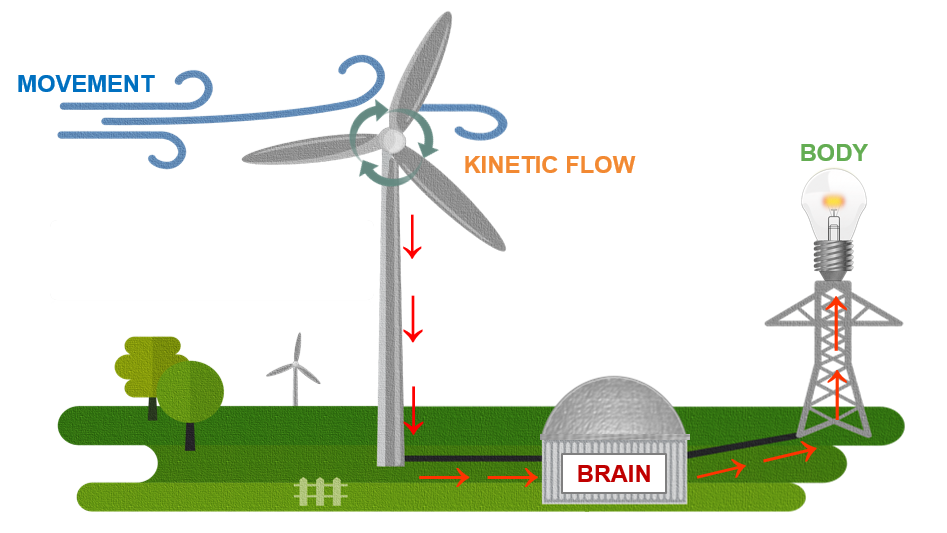
In the modern world, sitting is a way of life. From the time we start school, we are conditioned to sit still for hours at a time. All levels of education and the most jobs in modern countries require large amounts of sitting, as does the commute to and from school or the workplace.
Add to this the fact, that much of our leisure time is spent in sedentary activities: texting, tweeting, surfing the Internet, social media, playing video games, binge TV watching. All of these lead to further reductions in Kinetic Flow which paves the way for chronic pain.

There are some individuals in the health sector that would have you believe that pain experienced during prolonged sitting is just because you’re not sitting properly or in whatever special way they deem to be superior. [15] This position is not supported by the current scientific literature.
The research is quite clear that sitting itself is a problem – no matter what position you do it in.
- Sitting is consistently rated the # 1 position for aggravating back pain
- The more time you spend sitting, the greater the likelihood is that you will experience pain.[13,14]
How do you override and eliminate the pain caused by sitting too much? You increase Kinetic Flow!
That’s what a group researchers from Erasmus University in Rotterdam did. They created a specialized chair that passively moves a person while they sat. The researchers then tested pain levels in their chair against sitting in traditional chairs. [11]
They found that people engaged in passive motion while sitting had significant reductions in pain and nearly 25% of their subjects experienced near total relief.
Interestingly, the researchers were not able to explain how the small movements of the seat in their study resulted in a beneficial effect on low back pain. They tried to explain it using a biomechanical model whereby the movement of the chair provided nutrition to the disc but determined that tiny amount of motion that was used was “too small for significant motion in all lumbar spinal segments.”
The Kinetic Flow model, on the other hand, explains the results of this experiment perfectly. The pain that the people experience while sitting isn’t caused by a lack of nutrition to the spinal discs, the problem is so much bigger than that.
It is caused by a lack of Kinetic Flow, a nutrient that is absolutely essential for proper function of your brain. In this study, the movement of the chair generated Kinetic Flow which gave the brain the fuel it needs, and this is what led to less pain. [11]
What does this study mean for the rest of us?
It means we have to be aware that sitting for hours on end, day-in and day-out, leads to a chronic deficiency in Kinetic Flow. When we add to that, the tendency of the modern lifestyle to greatly reduce or eliminate altogether many of the traditional opportunities to stimulate Kinetic Flow and it’s not difficult to see why pain is such a huge problem in modern society.
Either one of these factors taken on its’ own has the power to wreak havoc in your body but, the combination of these two factors leads to something called Posture Prolapse Syndrome which magnifies the destructive effects on your health exponentially.
The easiest way to spot Posture Prolapse Syndrome is by identifying a forward head position. Normally, the ear hole should be directly in line with the center point of the shoulder (when viewing the body from the side).
When the ear hole is pushed way out in front of the center point in the shoulder, that’s forward head position.
Unfortunately, modern society is witnessing the deterioration of our physical structure on such a wide scale that forward head position has actually become the new “norm”. More people have this posture now than have normal posture.
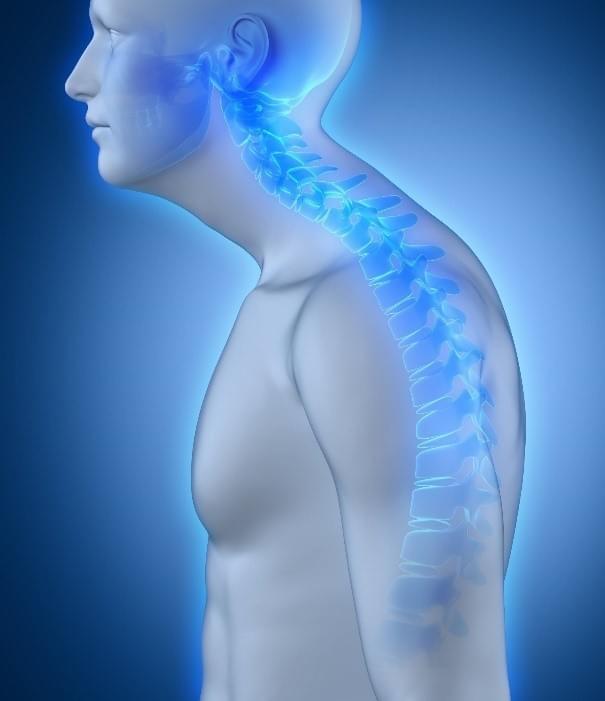
The one published study that looked at the incidence of forward position and found the incidence to be 66% of the population. [16] But, that study was published back in 1992!
That’s before the widespread use of smartphones, E-Readers, laptop computers, and non-stop social media & texting. This posture is so common nowadays, that it’s no longer the exception but, the rule. It’s more of the surprising when you see someone that doesn’t have it.
Besides Forward Head Position, other signs of PPS include:
- Thickening of the Trapezius muscles at the base of the neck [17]
- Rounding of the shoulders
- Outward bowing of the spine or the appearance of a hump back (Hyperkyphosis)
- Flattening of the buttocks
- Splaying of the feet – Loss of the arch structure
- Bunion formation
These structural changes are accompanied by:
- Physical dysfunction (which is most often expressed as mobility restriction)
- Not being able to do physical things the way you used to
- Reduced energy levels / Fatigue because it takes a lot of energy to hold yourself in an inefficient position all day, every day
- Pain
PPS has been directly linked to all the most-common pain conditions in the modern world. [18,19,20,21,22,23,24,25,26]
- Back Pain
- Neck Pain
- Disc Herniations
- Headaches
- Migraine
- Arthritis
- Carpal Tunnel
- TMJ
- Asthma
- Early Degeneration
- Decreased Functionality
How significant is the relationship between pain and Posture Prolapse Syndrome? At the International Fibromyalgia conference in Seattle one researcher was quoted:
“The major portion of head, neck, jaw, and shoulder pain experienced by many Fibromyalgia and CFIDS patients was attributed to the head and neck posture of the sufferer.” [23]
The link between structural deterioration and chronic pain is plain as day, once you know what you’re looking for. Take chronic shoulder pain, for example. The most-common causes of shoulder pain are injuries and tears to the rotator cuff. [27].
Research has demonstrated that the incidence of rotator cuff tears is 16-21 times greater with Posture Prolapse Syndrome [28]
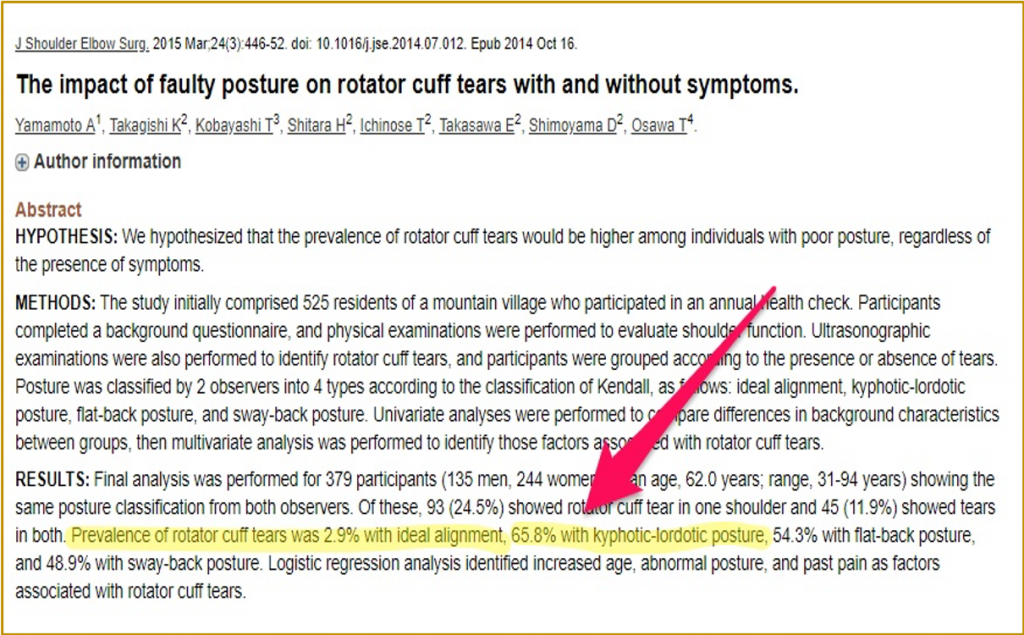
This research simply confirmed what I’ve seen in clinical practice for the last decade and a half. Over and over, I see patients suffering from shoulder pain they have torn rotator cuffs and no history whatsoever of trauma.
Modern medicine does a great job using advanced imaging procedures to diagnose these problems and their solution makes sense at the most basic level. It seems perfectly reasonable to go in surgically and sew the torn muscle back together, right?
The problem is that they never even bother to ask “Why?”.
- Why did a person, with no history of trauma, tear their muscle all of a sudden?
- What are the underlying issues that led to this problem in the first place?
Because, as it turns out, when you just go in and sew the torn rotator cuff back together and fail to address those other issues, 8 times out 10, it just re-tears! [29]
Why? Because the surgery does nothing to correct the underlying structural problems that set the stage for the injury in the first place.
Unfortunately, pain and injuries like rotator cuff tears are only the beginning when it comes to the problems caused by Posture Prolapse Syndrome. PPS negatively impacts functionality on all levels.
EVEN the simplest daily activities become much more challenging for people with PPS. Things like:
- Bending down to pick something up
- Getting up from a chair
- Walking
- Climbing stairs
- Holding on to something [30]
This is why PPS has been directly linked to loss of independence and increased need of assisted living in older people. [31,32]
Posture Prolapse Syndrome even interferes with the most fundamental of all human activities – breathing. PPS has been shown to lead to a loss of nearly 1/3 of your total lung capacity! To put that into perspective, that means that a person with advanced Posture Prolapse Syndrome operating at sea level would have about the same oxygen availability as a person with normal posture would have at an elevation of 11,000 feet. [31,33]
Pain is Only The Beginning
Posture Prolapse Syndrome slowly and quietly destroys your life. Here is a list of some of the recognized conditions that stem from Posture Prolapse:
- Pain
- Disc Herniations
- Nerve Compression
- Thoracic Outlet Syndrome
- Increased TMJ tension and Bite problems
- Chronic muscle strain
- Soft tissue pain syndromes
- Decreased blood flow to the spinal cord
- Early onset Degeneration and Arthritis
- Hemorrhoids
- Intestinal Problems
- Varicose Veins
- Osteoporosis
- Hip & Foot Deformities
- Poor Health
- Decreased Quality of Life
- Shortened Life Span
The first half of that list was published by The Mayo Clinic in the year 2000. The second half was published in the Journal of the American Medical Association and dates all the way back to 1957. [21,22]
Medicine has known exactly how important structural health is for over 60 years and yet, when was the last time your doctor looked at your posture? This massive problem is completely overlooked by modern medicine for only one reason – because they have no way of effectively treating it.
Physical structure gives more information about a person’s health status than you can possibly imagine. It can used to predict mortality.
People with PPS are:
- Almost 2½ times more likely to die from athlerosclerosis
- 2 times more likely to die from pulmonary causes
- 1½ times more likely to die from anything & everything [34]
Posture Prolapse Syndrome starves you of essential nutrients. It doesn’t just rob of these things in the moment, like sitting or holding your breath underwater does.
The effects of PPS build up inside your body. So, the damage compounds over time. If you don’t do something to reverse it, it creates pain and dysfunction every minute of every day until it robs you of your ability to move completely.
Thankfully, the opposite is also true….
And if you are willing to take charge of your health, educate yourself and grab the wheel then you’ll be able to sidestep the fatal flaw of conventional medicine’s approach to treating pain, and restore your structural birthright as well as the natural functionality that accompanies it and, you’ll be able to put kinetic flow to work for you – “feeding your brain and eliminating pain” 24 hours a day, seven days a week then you can eliminate your pain and get your life back. My members do it all the time.




The Pain Fix Protocol Master Class

What’s covered in The Pain Fix Protocol:
- The true meaning of pain
- The evolutionary rationale for pain’s existence
- Understanding the language of pain – your body’s way of speaking to you
- The critical distinction between acute and chronic pain
- The critical link between pain and functionality
- The Structural / Functional Continuum (Life Cycle)
- Establish clearly-defined standards for both structure and function – Once you reach this level of functionality, the odds of being in pain drop off significantly
- The root causes for the majority of the chronic pain associated with modern living.
- Strategies for overcoming common obstacles that stand in that way of getting to pain free. They include structural problems, joint mobility issues, muscle imbalances as well as lifestyle issues. We cover these in great detail because it makes no sense to be treating problems while at the same time creating or reinforcing the same problems.
- By identifying the root causes of these problems – we can create not only a more effective treatment solutions but also a much more efficient ones. We won’t have to waste time dealing with all the little downstream issues of big problems. Instead, we can fix the upstream issues and enjoy the certainty of knowing that the downstream ones will take care of themselves.
Over the years, there have been so many different issues that have brought people to my practice. Among the most common are:
- Headaches
- TMJ & Jaw Pain
- Fibromyalgia
- Chronic Fatigue
- Chronic Pain – Neck, Shoulder, Elbow, Wrist & Hand, Back, Hip, Knee, Ankle & Foot
- Multiple Sclerosis
- Lyme Disease
But, the one thing all these people have in common is pain. Pain sucking away their quality of life.
They can’t do the things they want to do anymore.
Chronic pain is a brutal thing to live with.
People suffering with it for any length of time have been built up and let down so many times that they have nothings left. Often times the people I work with have lost the light in their eyes and are emotionally flat because they’ve been hurting for so long.
Their first doctor wasn’t able to help them. And the person he/she referred them to, and the person after that either couldn’t help them or told them they were doomed to spend the rest of their lives in that painful state (or wait until it was so bad that a surgery could save them) that they stop trying.
I want you to know that change is possible. You can get your life back. PFP members do it everyday.
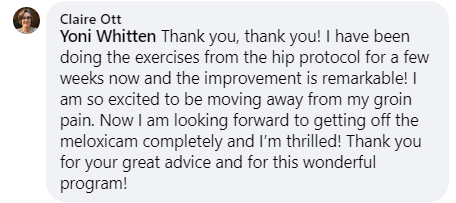

When you sign up, you’re going to get instant access to The Pain Fix Protocol masterclass.
In addition to the masterclass, you’re also going to get access to The Pain Fix Protocol Solutions series. This series will outline exactly what you need to do, from A to Z to resolve the most-common pain conditions in the modern world
The Pain Fix Protocol Solutions series are a compilation of the “greatest hits” pulled directly from my patient library – these are the same programs that I have used and perfected over the last 15 years to help people just like you get rid of their chronic pain and get their lives back.
The Pain Fix Protocol will allow you to streamline the process, start addressing the underlying issues that are the root cause of the vast majority of chronic pain conditions. The best part is many of the root causes of chronic pain can be eliminated on your own by using these scientifically-backed, proven methods.
- The Pain Fix Protocol Solutions series programs are your road map to resolution. They will provide you with the direction, the certainty and step-by-step instruction needed to get rid of the pain that is weighing you down and allow you to finally get your life back.
- The Pain Fix Protocol Solutions series make it faster and easier than ever before for you to get yourself out of pain and, once you’re there, to keep yourself pain-free for the rest of your life.
While there are slight modifications to the treatment protocol for each individual, there remains a very specific recipe for resolution for most chronic pain conditions. Because there are certain issues that crop up again and again –these issues must be addressed with almost every person suffering from chronic pain.
As part of The Pain Fix Protocol program, you’re going to get PFP Progress Tracker, that will allow you to objectively measure and track your improvement on the way to getting your life back – exactly the same way I do with my patients in the office.
You’ll have absolute certainty that you’re doing the right things every day to get yourself out of pain.
- With The Pain Fix Protocol you’re going to save yourself hours and hours of time spent searching the internet, reading books and scientific journals.
- You’ll end up saving yourself thousands of dollars on doctor visits, prescription drugs and days, weeks, months or even years of low quality living.
You might be saying to yourself:
“I’ve already seen so many doctors, physical therapists, surgeons, acupuncturists, massage therapists and they couldn’t figure my problem out. – It can’t really be that simple.”
Yes, it can! It’s true that chronic pain is often a complex, problem that is made up of many parts.
But, it is also true that the physiology of the human body is fixed – meaning your body has a set number of ways that it can respond to environmental input which is why there are certain commonalities between most, if not all, chronic pain conditions. And, the wonderful news is that once you begin resolving the large upstream issues, the downstream stuff tends to become much easier to address.
In addition to everything else, when you invest today, you’re also going to receive The Pain Fix Protocol Video Tutorial Series including over 70 step-by-step video tutorials covering every detail of the each and every one of the movements you are going to use to reset your pain forever.
- These are many of the same movements I use to help my patients get rid of their pain and get their lives back.
- Having lifetime access to the video tutorial series means you can go through the applicable videos at your own pace and review any movements that you need additional help with.
The Pain Fix Protocol Video Tutorial Series are going make it faster and easier than ever before for you to get yourself out of pain and more importantly, to keep yourself out of pain for the rest of your life.
You may be wondering whether you will be able do the movements/ exercises and stretches that are part of this program? Or, if they will be too complex?
- We always start with the least complicated, least stressful version of a movement and from there, we build it up so anyone can be successful.
- No matter how much pain you are starting with, we will meet you at that level and build you up over time at the pace that’s best for you.
- As you achieve higher and higher levels of functionality, your pain will naturally begin to fade away.
Also, when you purchase The Pain Fix Protocol, I am going to include a section on using sleep to combat chronic pain. In it, I am going to share:
- Powerful research that directly links sleep problems with chronic pain.
- Real-world strategies for how to set up your nightly routine to reduce and eliminate pain while you sleep.
- How to avoid the common sleep errors that keep so many people stuck in a lifetime of pain and disability.
With everything I’m including, the total value of The Pain Fix Protocol is well over $3,000!
But, because the whole point of this program is to be able to make these techniques available to everyone, I’m not going to charge you thousands of dollars.
But if I DID charge you $3,000 and it resolved your chronic pain, would it be worth it to you?
What wouldn’t you give for the opportunity to be pain free?
If you had a concrete plan in place to reduce or eliminate your chronic pain, what would it be worth to you?
The people that come to clinic pay thousands of dollars to work with me toward that very goal. When they put that money down, they don’t view it as an expense – they see it as an investment in their quality of life.
- You’ve already seen how The Pain Fix Protocol is worth over $3,000.
- And even at that price, which is close to what patients in my office would pay for this amount of information and instruction, it’s a great deal.
- But because my goal is to make this powerful and transformative information available to everyone that’s suffering from pain, I’m going to make you a very special offer.
You can get The Pain Fix Protocol for just $499
Let me put this into perspective; if you were to come out to Southern California and see me at my office, the initial visit alone would cost more than the price of this program.
The average total cost for a chronic pain treatment and rehabilitation plan at my clinic is over $4,000. But, because you’ve invested time reading this far and demonstrated that you’re highly motivated to free yourself from pain, I’m making a very special offer.
And because I want to offer every person suffering with pain as much information and as many science-backed tips, tools and strategies for eliminating pain as possible, I’m going to give you even more.
I teamed up with leading experts in the fields of health / wellness & neuroscience to add even more value to this program. So, for people that sign up for the Pain Fix Protocol as part of this promotion, I am going to offer two special bonus sections:
Bonus 1 – Best-selling author and health expert Ari Whitten guides you in how to use the power of light to eliminate pain and transform your body into a healing machine.
Bonus 2 – Best-selling author and neuroscience researcher Mark Waldman lays out the science & strategies for tapping into the power of your mind to wipe out pain.out
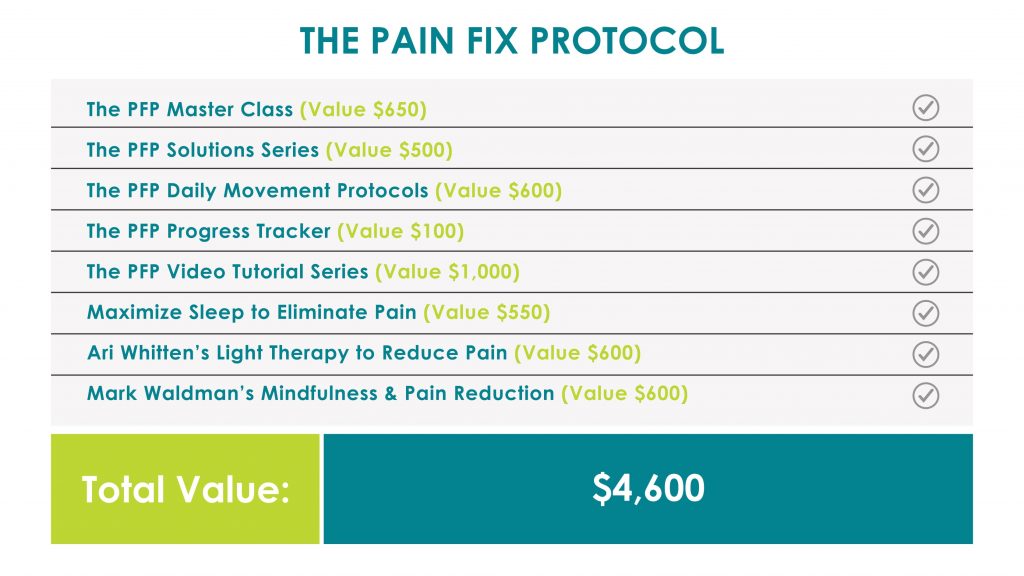
At this point, you’ve got two choices:
- Choice #1 is to do nothing. Just continue down the path you’re already on and keep getting the same results you’ve gotten up until now. You can go on suffering and look back fondly on the time in your life when you could do the things you love to do and didn’t hurt all the time.
- Choice #2 is to take a leap of faith. Start changing the way you view your pain, change what you’re doing and most importantly change the results you’re getting!

The great news here is that you have nothing to lose. I am so confident that this program will reduce or eliminate your pain that I am going to offer you a 30-day money-back guarantee.
So, here’s the real question: Is it worth gambling a few minutes of your time to check this out? Even if The Pain Fix Protocol resolves only half of what you’re dealing with, your life will be that much better for it.
You don’t live in pain. You have the power to break your pain cycle – all you need are the right tools and the correct strategy. Or, you can do nothing.
Worse than that, you can follow the erroneous path of modern medicine and:
- Take your pain killers and block the critically important messages that your body is desperately trying to get you to hear.
- Take your muscle relaxants and completely disregard the reasons that your body brought those muscles into a state of spasm in the first place.
- And rest. Thereby creating even greater deficiencies in Kinetic Flow – the one thing that’s proven over and over again in the scientific literature to be the single most important factor in getting people out of pain.
But why suffer needlessly? Why not let the Pain Fix Protocol show you how to get rid of your pain for good and get back to loving life.
When you invest in the Pain Fix Protocol – You’re going to get all – A total value of over $4,500 for just $499! Who would’ve thought that for less than $500 you could radically change your life?
So, join me and Let’s start eliminating your pain today!
References:
- Global Pain Management Report – Global Industry Analysts – http://www.prweb.com/pdfdownload/8052240.pdf
- Prevention and treatment of low back pain: evidence, challenges, and promising directions.N.E Foster, J.R Anema, D. Cherkin, R. Chou, S.P Cohen, D.P Gross, P.H Ferreira, J.M Fritz, B.W Koes, W. Peul, J.A Turner, C.G Maher. The Lancet Low Back Pain Series Working Group. The Lancet. Published: March 21, 2018
- Volinn E. The epidemiology of low back pain in the rest of the world. A review of surveys in low- and middle-income countries. Spine (Phila Pa 1976).1997 Aug 1;22(15):1747-54.
- Nag A, Desai H, Nag PK. Work stress of women in sewing machine operation. . J Human Ergology (Tokyo).1992 Jun;21(1):47-55.
- Xiaotong Liu, Limin Wang, MD, MPH, Lorann Stallones, PhD, Krista K. Wheeler, MS, Weiyan Zhao, MD, PhD,Gary Smith, MD, DrPH, and Huiyun Xiang, MD, PhD Back Pain among Farmers in A Northern Area of China. Spine (Phila Pa 1976). 2012 Mar 15; 37(6): 508–514.
- https://mindbody.io/blog/wellness/movement-beneficial-your-mental-health
- Darren E.R. Warburton, Crystal Whitney Nicol, and Shannon S.D. Bredin. Health benefits of physical activity: the evidence. Canadian Medical Association Journal. 2006 Mar 14; 174(6): 801–809.
- Hooshmand H. Chronic pain: reflex sympathetic dystrophy, prevention and management. Boca Raton (FL): CRC Press; 1993. p.33-55.
- Chestnut, J. Innate Physical Fitness & Spinal Hygiene. The Wellness Practice 2005. p.81
- Brink Y1, Louw QA. A systematic review of the relationship between sitting and upper quadrant musculoskeletal pain in children and adolescents. Man Ther. 2013 Aug;18(4):281-8.
- Leo L. van Deursen, Jaap Patijn, John R. Durinck, Ruud Brouwer, Jeanne R. van Erven-Sommers, and Bernard J. Vortman. Sitting and low back pain: the positive effect of rotatory dynamic stimuli during prolonged sitting. Eur Spine J. 1999 Jun; 8(3): 187–193.
- Angela Maria Lis,1,2Katia M. Black,3,4 Hayley Korn,3,4 and Margareta Nordin1,2 Association between sitting and occupational LBP. Eur Spine J. 2007 Feb; 16(2): 283–298.
- Nidhi Gupta,1,*Caroline Stordal Christiansen,1 David M. Hallman,2 Mette Korshøj,1 Isabella Gomes Carneiro,1 andAndreas Holtermann1 Is Objectively Measured Sitting Time Associated with Low Back Pain? A Cross-Sectional Investigation in the NOMAD study. Public Library of Science. Published online 2015 Mar 25.
- Robin McKenzie – The Lumbar Spine, Mechanical Diagnosis and Therapy. Vol. 1 2006.
- Gokhale, E. 8 Steps to a Pain-Free Back. Pendo Press. 2008.
- Griegel-Morris P, Larson K, Mueller-Klaus K and Oatis CA. Incidence of common postural abnormalities in the cervical, shoulder, and thoracic regions and their association with pain in two age groups of healthy subjects. Phys Ther.1992
- Harel R1, Lavelle WF, Riesenburger RI, Demers E, Benzel EC. Cervical kyphosis trapezius sign: a new sign for an old pathology. World Neurosurg. 2010 Dec;74(6):602-5
- Lee WY1, Okeson JP, Lindroth J. The relationship between forward head posture and temporomandibular disorders. J Orofac Pain. 1995 Spring;9(2):161-7
- De-la-Llave-Rincón AI1, Fernández-de-las-Peñas C, Palacios-Ceña D, Cleland JA. Increased forward head posture and restricted cervical range of motion in patients with carpal tunnel syndrome. J Orthop Sports Phys Ther. 2009 Sep;39(9):658-64
- Fernández-de-las-Peñas C1, Alonso-Blanco C, Cuadrado ML, Gerwin RD, Pareja JA. Trigger points in the suboccipital muscles and forward head posture in tension-type headache. Headache. 2006 Mar;46(3):454-60
- Freeman JT., Posture In The Aging and Aged Body, JAMA 1957; 165 (7), pp 843-84
- Mayo Clinic Health Letter, Vol. 18, No. 3, Mar 2000.
- Exclusive SHN Report from the Seattle Fibromyalgia International Team Conference. February 13, 1997. Sapient Health Network. https://chiro.org/LINKS/ABSTRACTS/dentist.shtml
- Lunardi AC, Marques da Silva CC, Rodrigues Mendes FA, Marques AP, Stelmach R, Fernandes Carvalho CR. Musculoskeletal Dysfunction and Pain in Adults with Asthma. J Asthma. 2011 (Feb); 48 (1): 105—110
- Kapreli E, Vourazanis E, Billis E, Oldham JA, Strimpakos N. Respiratory Dysfunction in Chronic Neck Pain Patients. A Pilot Study. Cephalalgia 2009 (Jul); 29 (7): 701—710
- Yip CH, Chiu TT, Poon AT. The Relationship Between Head Posture and Severity and Disability of Patients With Neck Pain Manual Therapy 2008 (May); 13 (2): 148—154
- Cleveland Clinic – Health Essentials: Shoulder Pain: 3 Most Common Causes and How to Fix It. June 20, 2017. https://health.clevelandclinic.org/shoulder-pain-3-most-common-causes-and-how-to-fix-it/
- Yamamoto A1, Takagishi K2, Kobayashi T3, Shitara H2, Ichinose T2, Takasawa E2, Shimoyama D2, Osawa T4. The impact of faulty posture on rotator cuff tears with and without symptoms. J Shoulder Elbow Surg.2015 Mar;24(3):446-
- Henry P1, Wasserstein D1, Park S1, Dwyer T2, Chahal J3, Slobogean G4, Schemitsch E5. Arthroscopic Repair for Chronic Massive Rotator Cuff Tears: A Systematic Review. Arthroscopy. 2015 Dec;31(12):2472-80.
- Deborah M. Kado,1Mei-Hua Huang,1 Elizabeth Barrett-Connor,2 and Gail A. Greendale1Hyperkyphotic Posture and Poor Physical Functional Ability in Older Community-dwelling Men and Women: The Rancho Bernardo Study. J Gerontol A Biol Sci Med Sci 2005 (May); 60 (5): 633—637
- Cathleen S. Colón-Emeric, MD, MHS, Heather E. Whitson, MD, MHS, Juliessa Pavon, MD, and Helen Hoenig, MD. Functional Decline in Older Adults Am Fam Physician. 2013 Sep 15; 88(6): 388–394.
- Huang MH1, Barrett-Connor E, Greendale GA, Kado DM.Hyperkyphotic Posture and Risk of Future Osteoporotic Fractures: The Rancho Bernardo Study. J Bone & Mineral Research 2006 (Mar); 21 (3): 419—4
- Don’t Die of Altitude Sickness” https://www.highuintapackgoats.com/high-altitude-sickness–unpredictable-weather-in-mountainous-regions.h
- Kado et al., Hyperkyphotic Posture Predicts Mortality in Older Community-Dwelling Men and Women. J of the Amer Geriatrics Society. 52 (10) 1662, 2004
